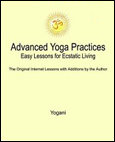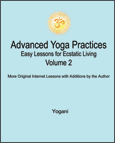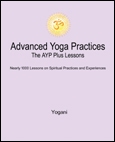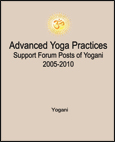|
Public Home | Plus Home | Main Lessons | Tantra Lessons | Public Forum | Plus Forum | Downloads | Books Topic Paths | Search | Training-Retreats | Testimonials | Survey | Interviews | MultiMedia | Contact | Donate |
|
Advanced Yoga Practices Note: For the Original Internet Lessons with additions, see the AYP Easy Lessons Books. For the Expanded and Interactive Internet Lessons, AYP Online Books, Audiobooks and more, see AYP Plus. Lesson 86 - Finding Your Meditation Routine (Audio)
AYP Plus Additions:
From: Yogani New Visitors: It is recommended you read from the beginning of the archive, as previous lessons are prerequisite to this one. The first lesson is, "Why This Discussion?" Q: I have just recently begun following your practices (went back to the beginning). I have been involved with yoga and meditation for several years. I wonder is it all right to continue to use background music and aromas to enhance my meditation, or am I distracting from it? What about mala beads? Also right now, I only seem to be able to get in about 10 minutes - how important is it to meditate for the full 20 minutes every day? A: Of course, it is not for me to upset your established comfortable environment for meditation. If you are most comfortable with incense, aromas, background music, or whatever, it is your choice. However, I do suggest you carefully read all the lessons on meditation, including the Q&As, for comments on external environmental things while meditating. Remember, meditation is for going in. If we are vibrating with music or other sensory inputs, this is not part of using the mantra, and there is the chance that our attention will be divided. This can take away from our attention settling naturally and deeply into pure bliss consciousness. Of course, as pointed out in the lessons, it is possible to meditate easily in airplanes, busy waiting rooms, or practically anywhere. So what is a little background music? It may not hurt, but it is not part of the meditation either, and it is something else besides thoughts that you will be easily letting go as you favor the mantra. You decide what works best for you. You are in charge. Ten minutes is much better than no minutes, and ten minutes twice a day is much better than twenty minutes only once a day. There is a natural cycle of meditation and activity that is optimized by meditating twice a day. The "twice" is at least as important as the length of meditation. If you are smooth in activity after twenty minutes of meditation, then do your best to build it into your daily schedule. You will accomplish so much more inner purification if you can get in the habit. On the other hand, try not to be erratic about it -- twenty minutes this time, ten minutes next time, then fifteen... The more regular it is, the more like clockwork it is, the better your nervous system will like it. Once the habit is in place, the nervous system will practically meditate itself. You will close your eyes and be in pure bliss consciousness immediately, and the peace and bliss of that will stay with you throughout the day and night. Meditation habituates our nervous system to be in pure bliss consciousness naturally. It really does work like that. It takes regular daily practice over a long time. As the obstructions are gradually removed, the experience of pure bliss consciousness steadily rises. It is like watching a tree grow. I wish I could say it is like watching a kudzu vine grow (much, much faster). Maybe for a few advanced souls born with pure nervous systems it is. Mala beads are for a different kind of approach to meditation, and to pranayama as well. They are for counting. Malas were around long before clocks, and the number of mantra repetitions and breathing cycles were counted to have a measured approach, so as not to overdo or underdo practices. This produces a small restriction, especially in meditation, because it ties the mantra to an outer activity, ticking off the beads one by one with the fingers. It becomes an unconscious habit, yet still we are regulating the mantra with an outer activity. With the clock, we can let the mantra (and the breath in pranayama) go naturally according to the unique purification need of the nervous system. We have talked a lot about this already. Using the clock is a flexible approach to measuring the amount of inner practices. Of course, we will peek at the clock now and then, but in time we find that our automatic inner clock is nearly as good as the outer one. The outer clock then becomes an occasional confirmation of the inner one. There is a lesson on this in the meditation Q&As called, "Watching the clock." Malas may also have a sentimental value, a bhakti value, and that is an okay reason for wearing them. Whatever stimulates your bhakti is good, as long as you are not blasting off the planet in a kundalini overdose. A mala may be part of your ishta (ideal) if it connects you with your chosen ideal. And maybe your meditation and pranayama learned elsewhere are mala-based. That is okay too. The mala has not been outdated, not going the way of the buggy whip any time soon. It has been around for thousands of years. But keep in mind, the mala is for measuring how much we do in practices. In these lessons we use the clock for that. That's the difference. I wish you the best on your journey homeward. The guru is in you. Discuss this Lesson in the AYP Plus Support Forum Note: For detailed instructions on deep meditation, see the AYP Deep Meditation book, and AYP Plus.
|
|
|
|
Join the Mail List:
AYP Retreats
eBooks - PDF, EPUB
FREE eBooks with
SAVE with Bundled
|

























